Do you have a question about the Winterhalter GS630 and is the answer not in the manual?
Explains symbols used for warnings and information in the manual.
Specifies authorized usage and restrictions for the utensil washer.
Details actions and conditions that constitute improper use of the device.
Provides guidelines for safe handling and use of cleaning chemicals.
Outlines essential safety precautions and user responsibilities for operating the machine.
Procedures for daily cleaning and upkeep of the washing machine.
Verifies that all components are present and undamaged upon delivery.
Steps for initial setup, connection, and operator training for the machine.
Safety precautions when handling rinse aid and detergent chemicals.
Explains the function and supply mechanism of rinse aid in the washing process.
Describes the necessity and methods of detergent supply for effective cleaning.
Details manual dosing procedures for detergent powder before and after wash cycles.
Explains how liquid detergent dosing is set and managed by service engineers.
Provides instructions and warnings for changing liquid detergents, including rinsing.
Describes the layout and functions of the machine's control panel and its indicators.
Explains the sequence of operations from warm-up to ready status and program execution.
Explains the Wash, Drain, Rinse, and Cold water pre-wash stages of the cycle.
Lists and describes the different available washing programmes and their applications.
Step-by-step guide on how to safely switch on the machine and prepare it for use.
Crucial checks to perform before powering on the machine, including safety.
Describes the process of powering on the machine and waiting for it to reach operational temperature.
Instructions for manual addition of detergent if automatic dosing is not used.
Details the washing process, including sorting dishes and starting cycles.
Guidelines for proper loading and arrangement of dishes for optimal washing.
Step-by-step instructions for executing the standard washing programme.
Actions to take during a pause or after a wash cycle, like checking filters.
How to access and use special programmes via the function key.
Explains the 'Short programme', 'Programmes with reduced rinsing temperature', 'Intensive programme', and 'Mode with manual cold water pre-wash'.
Procedures for checking dish cleanliness, error indicators, and detergent/rinse aid levels.
Visual guide for performing routine maintenance on filters, wash arms, and pipes.
Instructions on how to safely power down the machine.
Details daily maintenance tasks, including running the self-cleaning programme.
Step-by-step guide to initiating the machine's automatic self-cleaning cycle.
Procedures for manual cleaning of internal components like wash arms, filters, and sieves.
Guidelines for cleaning and maintaining the external surfaces of the machine.
Verifies the status and sufficiency of the external water treatment system.
Monthly maintenance tasks, including cleaning the dirt trap and descaling.
Instructions for cleaning the dirt trap to ensure proper water flow.
Procedures and safety precautions for using descaler to prevent scaling.
Recommends professional maintenance checks by authorised service engineers.
Steps for preparing the machine for extended periods of non-use.
Instructions for bringing the machine back into operation after a long break.
Explains error messages and indicators displayed on the operating panel.
Details specific error codes and their corresponding remedies.
Explains the meaning of red and blue flashing lights on the panel and their causes.
Lists common malfunctions, their possible causes, and recommended remedies.
Specifies the workplace noise emission value according to DIN EN ISO 3746.
Refers to VDI Guideline 2052 for ventilation system design.
Notes for service engineers on site selection and installation requirements.
Safety warnings and requirements for electrical connection by authorized personnel.
Details on the mains connection cable type and safety requirements.
Instructions for integrating the machine into the local equipotential bonding system.
Identifies the locations of detergent, rinse aid, and defoamer dosing points within the machine.
Instructions on how to set parameter P27 for external dosing device functionality.
Provides the overall physical dimensions of the GS 630 machine.
Shows the layout and location of various connection points on the rear of the machine.
Lists accessory items like supply hoses, drain pipes, and dirt traps.
Key considerations for local connections, regulations, and electrical safety.
Detailed specifications for water connection, quality, temperature, hardness, and flow.
Specifies position, construction, and drain pipe details for waste water connection.
Details position, construction, protection, and supply pipe requirements for electrical connection.
Explains symbols used for warnings and information in the manual.
Specifies authorized usage and restrictions for the utensil washer.
Details actions and conditions that constitute improper use of the device.
Provides guidelines for safe handling and use of cleaning chemicals.
Outlines essential safety precautions and user responsibilities for operating the machine.
Procedures for daily cleaning and upkeep of the washing machine.
Verifies that all components are present and undamaged upon delivery.
Steps for initial setup, connection, and operator training for the machine.
Safety precautions when handling rinse aid and detergent chemicals.
Explains the function and supply mechanism of rinse aid in the washing process.
Describes the necessity and methods of detergent supply for effective cleaning.
Details manual dosing procedures for detergent powder before and after wash cycles.
Explains how liquid detergent dosing is set and managed by service engineers.
Provides instructions and warnings for changing liquid detergents, including rinsing.
Describes the layout and functions of the machine's control panel and its indicators.
Explains the sequence of operations from warm-up to ready status and program execution.
Explains the Wash, Drain, Rinse, and Cold water pre-wash stages of the cycle.
Lists and describes the different available washing programmes and their applications.
Step-by-step guide on how to safely switch on the machine and prepare it for use.
Crucial checks to perform before powering on the machine, including safety.
Describes the process of powering on the machine and waiting for it to reach operational temperature.
Instructions for manual addition of detergent if automatic dosing is not used.
Details the washing process, including sorting dishes and starting cycles.
Guidelines for proper loading and arrangement of dishes for optimal washing.
Step-by-step instructions for executing the standard washing programme.
Actions to take during a pause or after a wash cycle, like checking filters.
How to access and use special programmes via the function key.
Explains the 'Short programme', 'Programmes with reduced rinsing temperature', 'Intensive programme', and 'Mode with manual cold water pre-wash'.
Procedures for checking dish cleanliness, error indicators, and detergent/rinse aid levels.
Visual guide for performing routine maintenance on filters, wash arms, and pipes.
Instructions on how to safely power down the machine.
Details daily maintenance tasks, including running the self-cleaning programme.
Step-by-step guide to initiating the machine's automatic self-cleaning cycle.
Procedures for manual cleaning of internal components like wash arms, filters, and sieves.
Guidelines for cleaning and maintaining the external surfaces of the machine.
Verifies the status and sufficiency of the external water treatment system.
Monthly maintenance tasks, including cleaning the dirt trap and descaling.
Instructions for cleaning the dirt trap to ensure proper water flow.
Procedures and safety precautions for using descaler to prevent scaling.
Recommends professional maintenance checks by authorised service engineers.
Steps for preparing the machine for extended periods of non-use.
Instructions for bringing the machine back into operation after a long break.
Explains error messages and indicators displayed on the operating panel.
Details specific error codes and their corresponding remedies.
Explains the meaning of red and blue flashing lights on the panel and their causes.
Lists common malfunctions, their possible causes, and recommended remedies.
Specifies the workplace noise emission value according to DIN EN ISO 3746.
Refers to VDI Guideline 2052 for ventilation system design.
Notes for service engineers on site selection and installation requirements.
Safety warnings and requirements for electrical connection by authorized personnel.
Details on the mains connection cable type and safety requirements.
Instructions for integrating the machine into the local equipotential bonding system.
Identifies the locations of detergent, rinse aid, and defoamer dosing points within the machine.
Instructions on how to set parameter P27 for external dosing device functionality.
Provides the overall physical dimensions of the GS 630 machine.
Shows the layout and location of various connection points on the rear of the machine.
Lists accessory items like supply hoses, drain pipes, and dirt traps.
Key considerations for local connections, regulations, and electrical safety.
Detailed specifications for water connection, quality, temperature, hardness, and flow.
Specifies position, construction, and drain pipe details for waste water connection.
Details position, construction, protection, and supply pipe requirements for electrical connection.
| Brand | Winterhalter |
|---|---|
| Model | GS630 |
| Category | Dishwasher |
| Language | English |
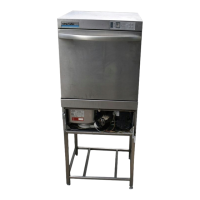


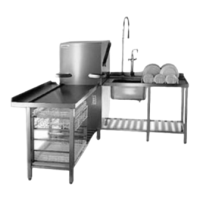

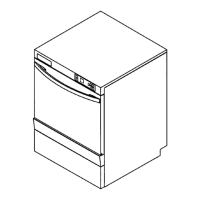
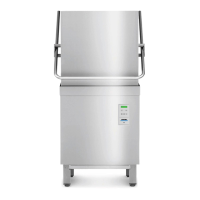
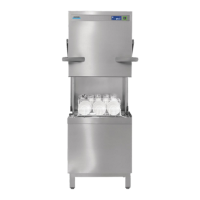


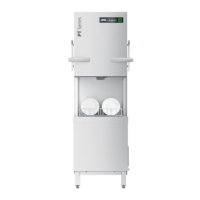
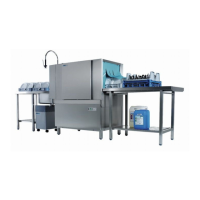
